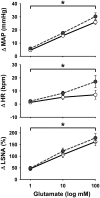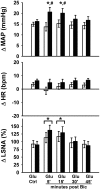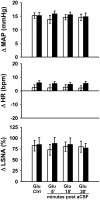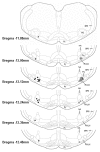Selective enhancement of glutamate-mediated pressor responses after GABA(A) receptor blockade in the RVLM of sedentary versus spontaneous wheel running rats
- PMID: 23189062
- PMCID: PMC3505845
- DOI: 10.3389/fphys.2012.00447
Selective enhancement of glutamate-mediated pressor responses after GABA(A) receptor blockade in the RVLM of sedentary versus spontaneous wheel running rats
Abstract
Overactivity of the sympathetic nervous system (SNS) is a hallmark of many cardiovascular diseases. It is also well-known that physical inactivity independently contributes to cardiovascular diseases, likely in part via increased SNS activity. Recent work from our laboratory has demonstrated increased SNS responses in sedentary animals following either direct activation or disinhibition of the rostral ventrolateral medulla (RVLM), an integral cardiovascular brainstem region. These data led us to hypothesize that the interaction between excitation and inhibition of the RVLM is altered in sedentary versus physically active animals. To test this hypothesis, we recorded mean arterial pressure (MAP) and lumbar sympathetic nerve activity (LSNA) in Inactin anesthetized rats that were housed for 8-12 weeks with or without access to a running wheel. Pressor responses to direct activation of the RVLM with glutamate were similar between groups under intact conditions. However, blockade of γ-aminobutyric acid (GABA)(A) receptors with bicuculline selectively enhanced pressor responses to glutamate in sedentary animals. Interestingly, LSNA responses to glutamate were not enhanced in sedentary versus active animals in the presence or absence of tonic GABAergic tone. These results suggest that sedentary compared to active conditions enhance GABAergic inhibition of glutamate-sensitive neurons in the RVLM that are involved in blood pressure regulation, and by mechanisms that do not involve LSNA. We also speculate that regular physical activity has differential effects on SNS activity to specific vascular beds and may reduce the risk of developing cardiovascular diseases via changes occurring in the RVLM.
Keywords: GABA; blood pressure; brainstem; exercise; glutamate.
Figures





Similar articles
-
Sedentary conditions and enhanced responses to GABA in the RVLM: role of the contralateral RVLM.Am J Physiol Regul Integr Comp Physiol. 2017 Aug 1;313(2):R158-R168. doi: 10.1152/ajpregu.00366.2016. Epub 2017 May 10. Am J Physiol Regul Integr Comp Physiol. 2017. PMID: 28490450 Free PMC article.
-
Altered Differential Control of Sympathetic Outflow Following Sedentary Conditions: Role of Subregional Neuroplasticity in the RVLM.Front Physiol. 2016 Jul 19;7:290. doi: 10.3389/fphys.2016.00290. eCollection 2016. Front Physiol. 2016. PMID: 27486405 Free PMC article.
-
Exercise training attenuates increases in lumbar sympathetic nerve activity produced by stimulation of the rostral ventrolateral medulla.J Appl Physiol (1985). 2007 Feb;102(2):803-13. doi: 10.1152/japplphysiol.00498.2006. Epub 2006 Oct 19. J Appl Physiol (1985). 2007. PMID: 17053106
-
Medullary and supramedullary mechanisms regulating sympathetic vasomotor tone.Acta Physiol Scand. 2003 Mar;177(3):209-18. doi: 10.1046/j.1365-201X.2003.01070.x. Acta Physiol Scand. 2003. PMID: 12608991 Review.
-
Role of the caudal pressor area in the regulation of sympathetic vasomotor tone.Braz J Med Biol Res. 2008 Jul;41(7):557-62. doi: 10.1590/s0100-879x2008000700002. Braz J Med Biol Res. 2008. PMID: 18719736 Review.
Cited by
-
Blood pressure is maintained during dehydration by hypothalamic paraventricular nucleus-driven tonic sympathetic nerve activity.J Physiol. 2014 Sep 1;592(17):3783-99. doi: 10.1113/jphysiol.2014.276261. Epub 2014 Jun 27. J Physiol. 2014. PMID: 24973410 Free PMC article.
-
Subregional differences in GABAA receptor subunit expression in the rostral ventrolateral medulla of sedentary versus physically active rats.J Comp Neurol. 2020 Apr;528(6):1053-1075. doi: 10.1002/cne.24798. Epub 2019 Nov 21. J Comp Neurol. 2020. PMID: 31642070 Free PMC article.
-
Revisiting differential control of sympathetic outflow by the rostral ventrolateral medulla.Front Physiol. 2023 Jan 17;13:1099513. doi: 10.3389/fphys.2022.1099513. eCollection 2022. Front Physiol. 2023. PMID: 36733693 Free PMC article.
-
Physical activity correlates with glutamate receptor gene expression in spinally-projecting RVLM neurons: a laser capture microdissection study.Brain Res. 2014 Oct 17;1585:51-62. doi: 10.1016/j.brainres.2014.06.021. Epub 2014 Aug 28. Brain Res. 2014. PMID: 25173073 Free PMC article.
-
Neural control of the circulation during exercise in health and disease.Front Physiol. 2013 Aug 26;4:224. doi: 10.3389/fphys.2013.00224. eCollection 2013. Front Physiol. 2013. PMID: 23986718 Free PMC article. No abstract available.
References
-
- Bauer R. M., Iwamoto G. A., Waldrop T. G. (1989). Ventrolateral medullary neurons modulate pressor reflex to muscular contraction. Am. J. Physiol. Regul. Integr. Comp. Physiol. 257, R1154–R1161 - PubMed
Grants and funding
LinkOut - more resources
Full Text Sources

